Easy, layered savory crepes with a spinach and cheese filling are a flavorful twist to the classic crepe. Delicious crepes are neatly stacked, generously stuffed, luxuriously topped, and baked until golden. Shall we?

Jump to:
Background
Here is a great crepe lunch or dinner idea: layered savory crepes with a rich spinach and cheese filling!
Savory crepes are easy to make! They take a little bit of time - you have to fry each separately - but other than that, they're super simple to prepare.
To recap, crepes are nothing more than super thin, wide, pancakes. They're deliciously neutral in taste. Fillings make them savory or sweet.
Moreover, if you want to make crepes into a lunch or dinner, the best way to do this is to make a richer filling. Our spinach and cheese filling is exactly that!
In addition to stuffing crepes with a hearty filling, we stack them on top of each other, until the dish looks like a mini cake.
Add to that a scrumptious egg and sour cream topping (and a quick bake!), and you've left with the most tasty and golden layered savory crepes ever!
Ingredients
To make the savory crepe batter (which is really the same as regular crepe batter), as well as the flavorful spinach filling - you'll need the following:
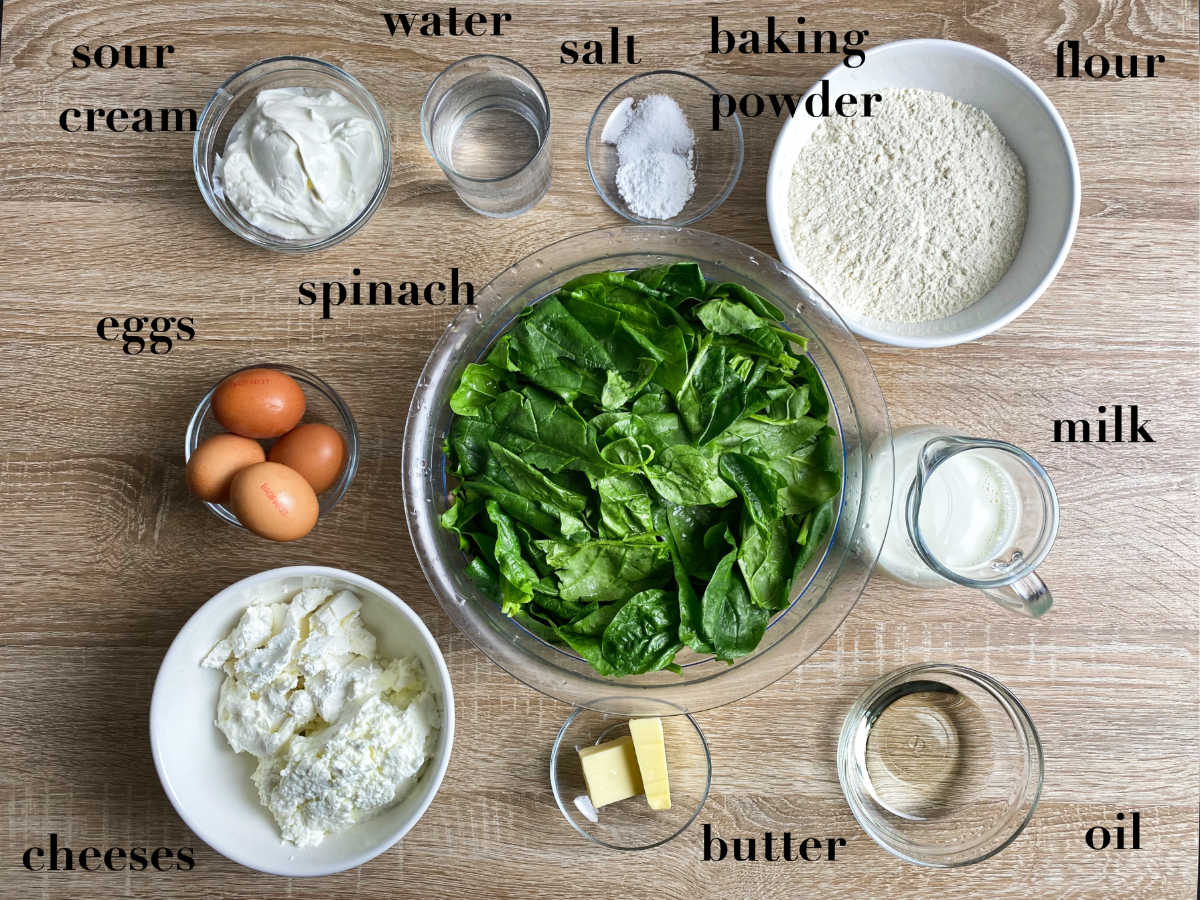
- White Flour - we haven't tried using different flours. If you have, leave a comment below!
- Baking Powder - to make them fluffier.
- Salt - just a pinch.
- Eggs - regular eggs.
- Milk - regular or almond milk are best. Substitute with water if you must.
- Oil - to grease the pan in between crepes.
- Baby Spinach - washed and cut into thin stripes.
- Feta - feta, local Travnik cheese, or Halloumi are the best.
- Sour Cream - regular sour cream.
- Soft Cheese - goat cheese, Ricotta, even cottage work well.
- Butter - regular butter.
Instructions
Here are the instructions for today's dish:

Step 1. Make Batter.

Step 2. Fry Crepes.

Step 3. Make Filling.

Step 4. Fill Crepes and Bake.

Step 5. Make Topping, Pour and Bake.
Recipe FAQs
We found these secrets to be of the greatest importance:
- The batter should rest in the fridge for at least 1-2 hours (if you have the time).
- Also, the batter needs to be completely smooth and crumb-free.
- The pan (preferably the crepe pan) has to be extremely hot.
- Practice!
Our savory crepe recipe is a standalone dish!
If you want to add an appetizer or a salad, we recommend the local meat and cheese board meza, roasted red pepper sauce, cabbage salad, or a soup like cream of spaghetti squash, or egg drop soup.
There are a million different savory crepe fillings, and filling combinations! Here are some ideas:
- Mushrooms
- Seasonal Veggies
- Ham and cheese
- Fish
- Ground beef or pork
- Chicken
- Feta
- Eggs.
Handling
- Serving: serve warm. Add a soup, or some meat patties if you want to make it into an even more decadent dish. Also, shopska salad goes fantastic with it!
- Storing: store in an airtight container for up to 2 days.
- Reheating: reheat using your favorite method.
More Crepe and Spinach Recipes
You may like some of our other crepe or spinach goodies!
Thoughts?
If you made savory crepes with spinach and cheese filling and liked it, please consider giving it a ⭐️⭐️⭐️⭐️⭐️ (5-star) rating. This helps others find the recipe more easily!
Also, feel free to leave a comment (I read each one!), and don't forget to tag a photo #balkanlunchbox, or us @balkanlunchbox, on IG.
Prijatno, Dobar Tek, and Bon Appetit!
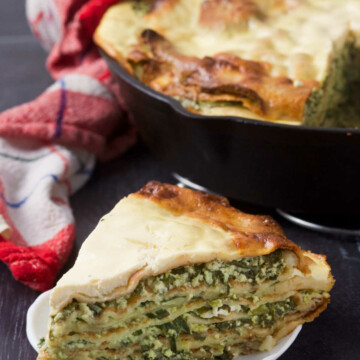
Savory Crepes with Spinach and Cheese Filling
Equipment
- 1 round 9-inch crepe pan
- 1 round 10-inch baking pan
Ingredients
Crepes:
- 1.5 cups white flour (about 12 ounces)
- 1 teaspoon baking powder
- ½ teaspoon salt
- 2 eggs
- 2 cups milk cold
- 1 cup water cold
- ½ cup oil to grease the pan
- 2-3 paper towel pieces to grease the pan
Filling:
- 12-14 ounces baby spinach thoroughly washed and cut into thin strips
- 1-2 eggs
- 7 ounces feta cheese crumbled
- 7 ounces ricotta cheese or another soft cheese like goat or cottage
- 7 ounces sour cream
- 1 teaspoon salt
- 2 tablespoons melted butter
Topping:
- 1-2 eggs
- 7 ounces sour cream
Instructions
- In a medium mixing bowl combine flour, baking powder, and salt. Mix with a spatula. Add milk and eggs and blend on high with a hand mixer for 2-3 minutes, slowly adding water as you mix. Mix until completely smooth. Turn the mixer off and scrape bits of flour from the sides of the bowl. Blend again for 1-2 minutes until all the crumbs and scrapes are gone. (Optional: leave the batter in the fridge for a couple of hours before frying crepes.)
- Heat the crepe pan on high. When the pan is hot, dip a paper towel in oil and coat the pan with it (watch your fingers!). Using a ladle, pour about ½ cup batter onto the pan and quickly swirl it around until the batter coats the pan evenly. Fry on medium to medium-high for about 1 minute and 15 seconds on each side. Transfer to a plate. Repeat until you run out of batter. You should have about 12-ish crepes.
- Make the filling by combining all ingredients in a medium mixing bowl and whisking until completely integrated.
- Heat oven to 395°F (200°C). (You can adjust the temperature a little bit based on your oven.) Coat the baking pan with oil and place one crepe on the bottom. Spread 2-3 tablespoons of the filling over the crepe evenly. Repeat until you run out of crepes and filling. (Do not put the filling on the top crepe.) Place the crepe pie in the oven and bake for 15 minutes.
- Whisk up the topping in a small mixing bowl. Take the crepe pie out of the oven and pour the topping over it evenly. Return to the oven for another 15 minutes. If it starts to blush too much cover with foil.
- Serve warm by itself or add a soup, meat patties or a shopska salad. Store in an airtight container for up to 2 days. Reheat using your favorite method.
Video
Notes
- Time
- Batter
- Serving size

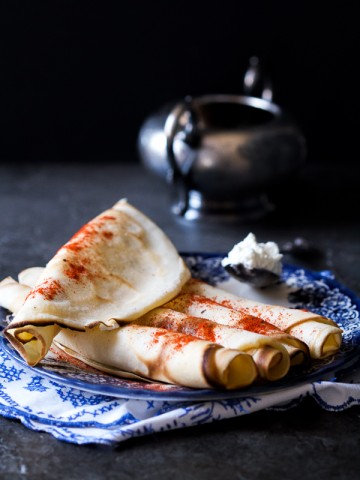
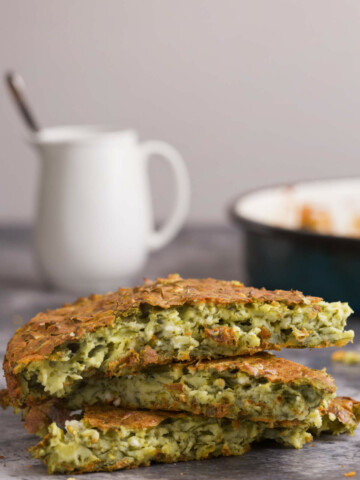
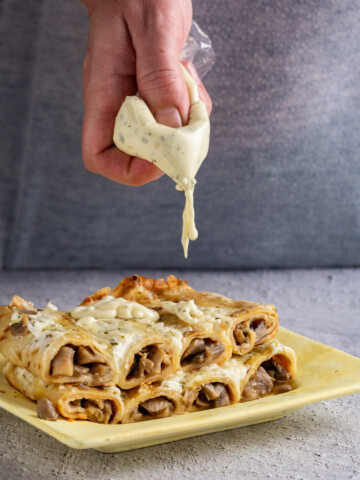
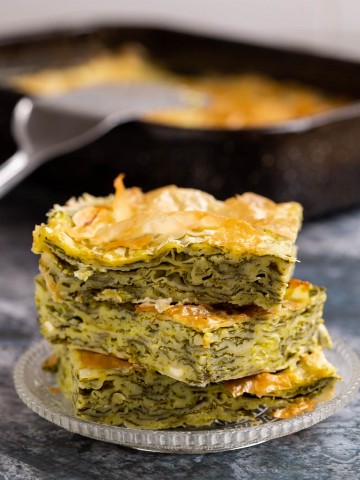
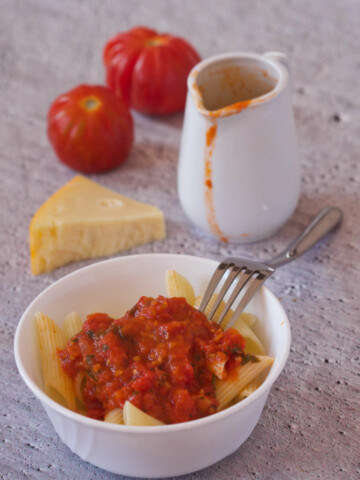
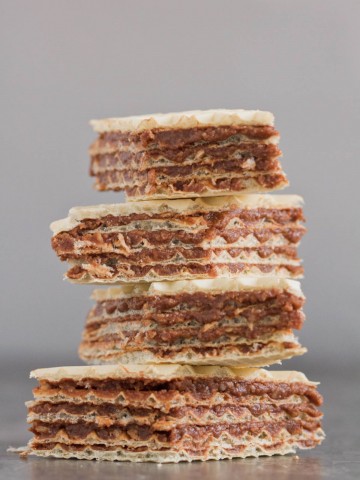
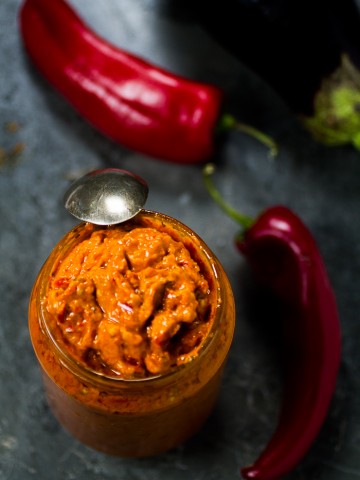
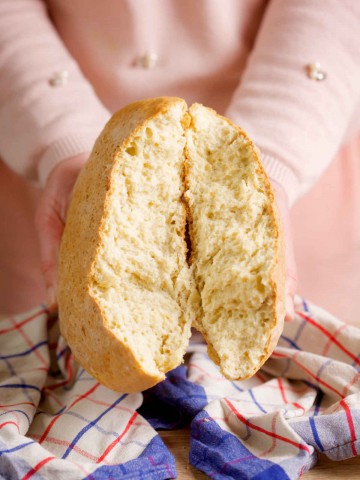

Leave a Reply